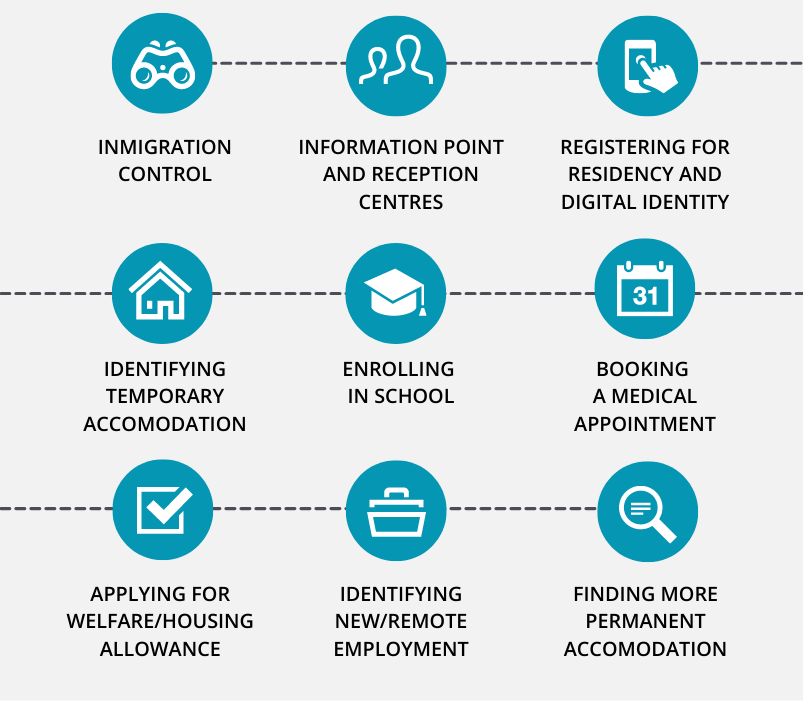This year, the UNHCR announced that the number of people forcibly displaced exceeded 100 million globally for the first time on record. This means 1 in every 78 people has been forced to flee their homes. The number of people displaced, internally or externally, from weather-related disasters, famine and unemployment is also rising. The Institute for Economics and Peace (IEP) estimates that there could be 1.2 billion climate refugees by 2050.
A proactive approach is needed to help manage this perennial challenge and to improve the lives of refugees. Or, in the words of the Mayor of Warsaw, Poland, “it is time we phased out improvisation and instead created a strategy for coping and appropriate systems for helping refugees.”
To create more effective and empathetic systems for refugees, governments and their partners should consider taking a life-event approach. The life-event approach to digital service delivery includes bringing a range of services together to coincide with a particular event, such as a birth, marriage, and death. Rather than people having to reach out to a variety of agencies to access different services, governments can integrate information and resources to provide these services in a more seamless way.
More mature approaches also include service coordination and data exchange across agencies as well as with private sector and civil society organisations.
Some governments, including the US Federal Government, have started to take a life event approach to disaster response, from floods to wildfires. These sudden and unplanned life events require citizens and residents to access services from several agencies and require a more empathetic and personalised approach.
The same can be applied to the arrival of a refugee. When refugees arrive in a new country, they generally need to register for residency and digital identity, whether through the government or an NGO, and need immediate access to food, cash programs, and shelter. These short-term needs then morph into longer terms needs, including accessing healthcare services, education, and the labour market.
Taking a life event approach and bundling these services together can help to make often bureaucratic systems and services easier to navigate. This is even more important for vulnerable populations in a time of need and uncertainty. It can also improve efficiency, save time, and reduce costs for government agencies.
For example, in New Zealand, the government created SmartStart, a cross-agency online service to help parents navigate government services around the birth of a child. In its first year, the service resulted in 6,000 fewer visits to the Ministry of Social Development and has been well received by parents, midwives, and NGOs.
However, this should not be seen as a replacement for face-face support when needed. Some groups of refugees, such as unaccompanied minors or people with cognitive or physical disabilities, may require additional specialised and hands-on support from governments and NGOs

Source: IDC 2022
The Government of Portugal is leading the way in providing joined-up services for refugees. The Borders and Immigration Service has set up the Temporary Protection Regime for Ukrainian refugees. When Ukrainian refugees register through the online portal or in person, they receive identity numbers from key agencies including a tax identification number, social security identification number, and a national health service user number so that they can access key services.
Providing integrated services organised around planned or sudden lifetime events comes with its own challenges. It requires governments to set up the right governance mechanisms to collaborate across departments, share data in a secure and trusted way, and share budgets to enable integrated service delivery.
This is no small feat and requires a strategic approach and strong leadership, but there are examples of governments successfully overcoming these barriers.
National and local governments and international institutions looking to improve the lives and livelihoods of refugees should embrace this approach.
Leveraging technology for humanitarian purposes — HumTech — will require the right political motivation and leadership to turn refugee management from an ad hoc response to a crisis to a more systematic response to a perennial challenge.
For more information about technology and it’s impact on refugees:
- Download our eBook on HumTech here.
- Read our blog: How Can Technology Be Leveraged to Improve the Lives of Ukrainian Refugees?
To explore more of our coverage, please visit our Government Insights page.
Get in touch:
- Louisa Barker: lbarker@idc.com
- Joe Dignan: jdignan@idc.com


